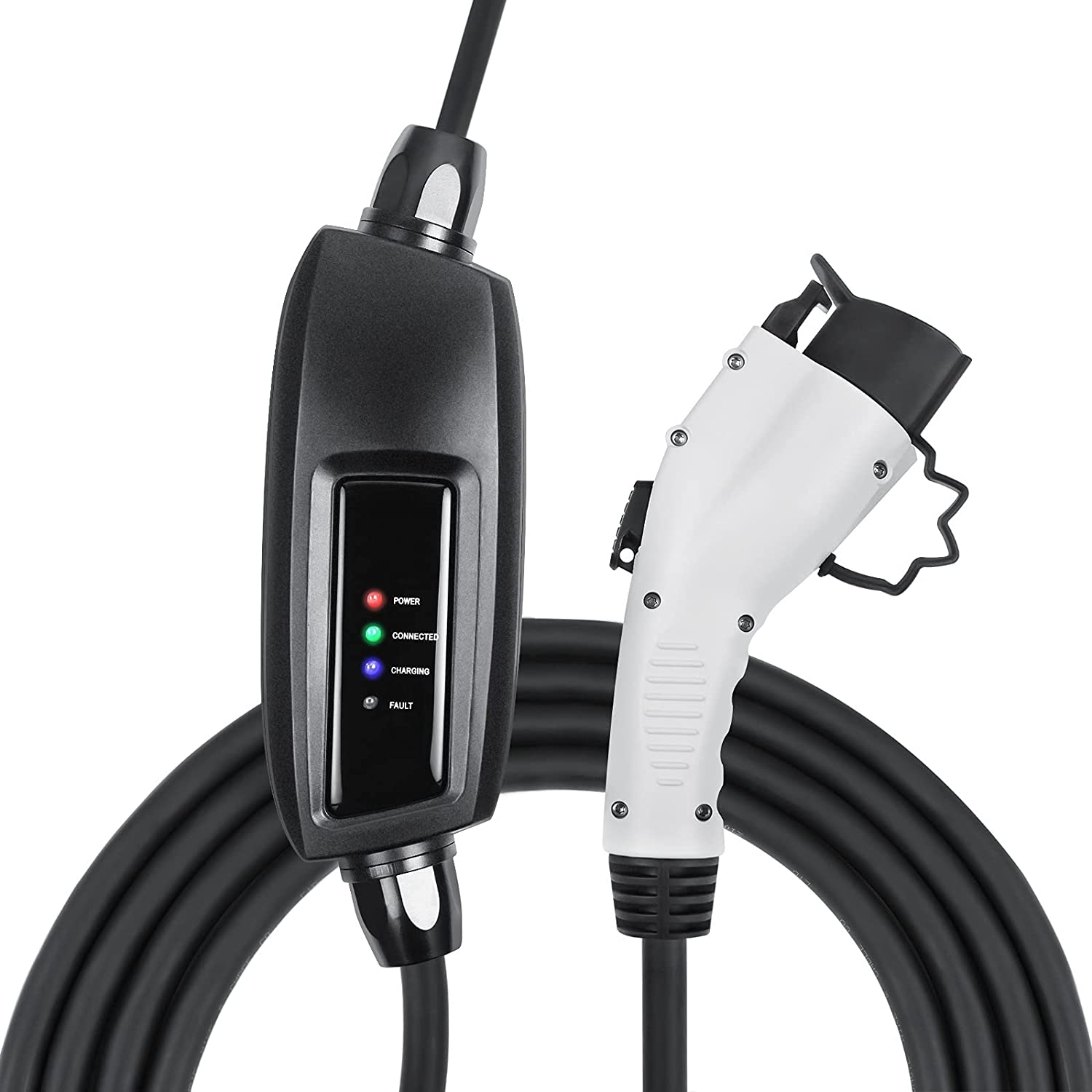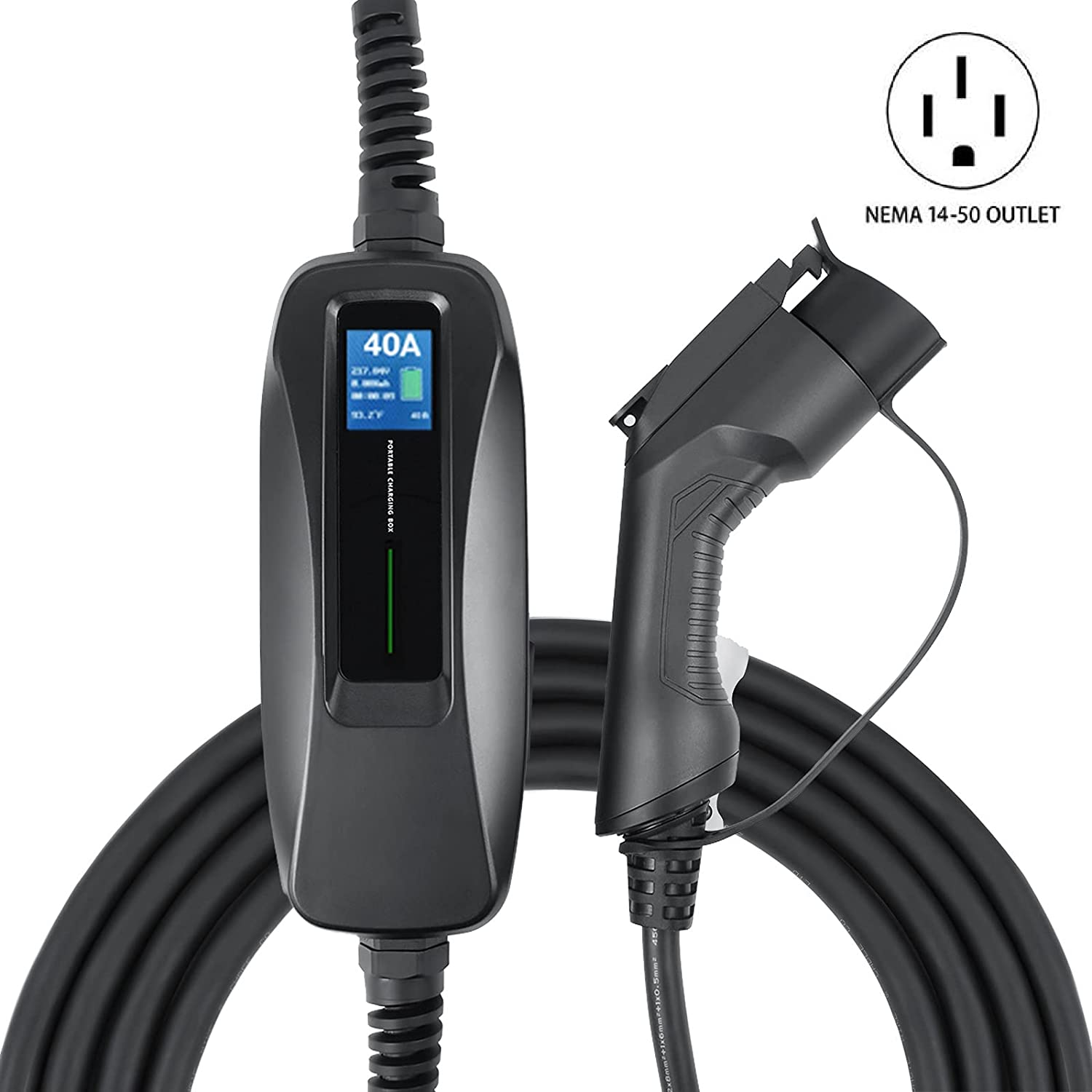PROS: Very fast charging speeds (32-Amp and 40-Amp) Adjustable Amperage (32-Amp model only), IP rating.
CONS: No connectivity or Smartphone App.
| Product | Amp rating | Level | Cable Length | Nema | Power | Price |
|---|---|---|---|---|---|---|
Lectron – Level 2 Portable EV Charger (16 Amp)  | 16 Amp | Level 2 | 21 Feet (6.4M) | NEMA 10-30 & NEMA 6-20 | 3.86 kW | Click for more info |
Lectron – Level 2 Portable EV Charger (32 Amp)  | 32 Amp | Level 2 | 21 Feet (6.4M) | NEMA 14-50 | 7.8 kW | Click for more info |
Lectron – Level 2 Portable EV Charger (40 Amp)  | 40 Amp | Level 2 | 18 Feet (5.4M) | NEMA 14-50 | 9.6 kW | Click for more info |
Lectron – Level 2 Portable EV Charger (16 Amp) Specifications
| Amp rating | 16 Amp |
|---|---|
| Level | Level 2 |
| Type | Portable EV Charger |
| Cable Length | 21 Feet (6.4M) |
| Nema | NEMA 10-30 & NEMA 6-20 |
| Power | 3.86 kW |
| Voltage | 240V |
| Connector | J1772 |
| Connectivity | None |
| IP Rating | N/A |
| Display | 4 LED Lights |
| Warranty | 1-Year No-Hassle |
| Features | Hassle-free Charging for your EV, Quick and Effortless EV Charging, One Cable, All Vehicles, Avoid Errors, Manage Expectations |
| What’s in the box | Charger, Cable, Plug |
| Weight | 6.98 lbs (3.1 kg) |
| Features | Tethered, Alexa & Google Home, Charge Scheduling |
Lectron – Level 2 Portable EV Charger (16 Amp) Charging specifications
These are the 3 versions of the Lectron Level 2 Portable EV Charger: 16 Amp, 32 Amp and 40 Amp. Interestingly, while most manufacturers offer the same form factor in their product line and just a different amperage and charging rate, in this one all the 3 chargers look inherently different and we’ll get to that part.
For now, let’s look at the charging speed because that’s the one that matters the most: How many miles of range do you get per each hour of charging? If you use the 16 Amp portable electric vehicle charger with a 3.86 kW charging rate, a standard Tesla Model 3 will take 13 hours to charge, so will a Volkswagen ID.3 Pure, ID.4 Pure and Renault Zoe. The Long Range Model 3 will take a hefty 18.5 hours. If you are the EV owner of a Kia Niro or a Hyundai Kona, you’ll be interested to know that it will take 17 hours. The Tesla Model Y, ID.3 Pro and ID.4 Pro will take 19.5 hours. The Mustang Mach E will take 18.5 hours to charge.
Now if you use the 32-Amp electric car charger, you’ll get a charging rate of 7.8 kW which will drastically speed up the charging time: The same standard Tesla Model 3 will now charge in just 6.5 hours and so will the ID.3 Pure, ID.4 Pure and the Renault Zoe. If you drive the Long Range Model 3, you’ll be delighted to know it will now charge in just 9.5 hours. The Model Y will charge its huge 75 kWh battery pack in just 9.5 hours and so will the ID.3 Pro and ID.4 Pro. A Hyundai Kona or a Kia Niro will now charge in just 9 hours and the standard Mustang Mach E now takes just 9 hours to charge.
Then there is the 40-Amp portable EVSE charger and here, things are mixed because not all cars can support its high 9.6 kW charging rate. So for example, the standard Model 3, ID.3 Pure, ID.4 Pure and Renault Zoe will take the same 6.5 hours to charge its battery as with the 32-Amp model. But the Long Range Tesla Model 3 will now charge in just 8 hours because it can support high-speed charging and so will the ID.4 Pro and ID.3 Pro. The Mustang Mach E will take just 7.5 hours to charge now.
All three chargers work at a 240V voltage, so as you can see, the 40 Amp model is worth it especially if you have a car that can make use of its charging power.
Lectron – Level 2 Portable EV Charger (16 Amp) Cable types and connectors
In terms of cable length, the 16-Amp and 32-Amp versions have a cable that is 21 feet long (About 6.4 meters), however the 40-Amp home EV charger has a cable that is just 18 feet long (5.4 meters). All of these cables are a bit shorter than we would like, because they fall below the 25 feet that is standard for home chargers in this price range. The cable cannot be easily disconnected either because all the chargers made for the North American market are tethered.
Sometimes you don’t want to install an additional plug in your garage and you just want to make due with what you have at the moment, so we’ll explain what kind of wall connector each charger has: The 16-Amp can plug in a NEMA 10-30 or a NEMA 6-20 wall socket while the 32-Amp and the 40-Amp models use a NEMA 14-50 socket.
On the other end of the cable, all three use the same standard J1772 charge port to charge your car.
Lectron – Level 2 Portable EV Charger (16 Amp) Features
These are not smart chargers, none of them have any kind of connectivity or integration with an Alexa device or smartphone app.
But each of them is a different form factor, so let’s start with the 16-Amp which has the standard Duosida style control box. It has 4 LEDs which show you if the charger is powered up, if it is charging or if there is a fault.
The 32-Amp model has the same LEDs however, it also has an LCD display that shows you the charging status, rate and charging level together with a timer that shows you for how long it has been charging. There are also the + and – buttons that let you adjust the amperage to either 32, 16, 13 or 10 Amps.
The 40-Amp model cannot adjust the Amps but it still has an LCD display with a nicer layout, but the information that it shows is essentially the same one that you get on the 32-Amp.
What all 3 models lack is a scheduled charging feature which can help you use off-peak electricity to reduce charging cost on the electric energy bill, however it is very likely that your new EV already has that.
We couldn’t find any info on the IP rating for these chargers however, we do know that the 16-Amp uses the Duosida control box which is IP55 rated, the 32-Amp uses another type of Duosida control box which should be IP67 rated and the 40-Amp uses the same control box as the portable Besenergy 40-Amp charger which is IP66 rated. None of these claims represent any official information, they’re just a best guess that is based on their control boxes.
All 3 chargers come with a 1-Year warranty.
